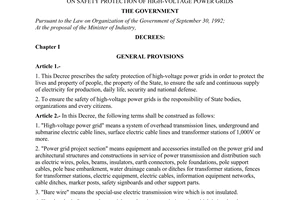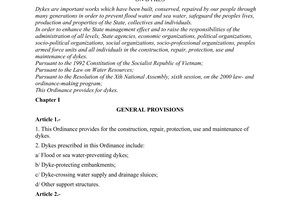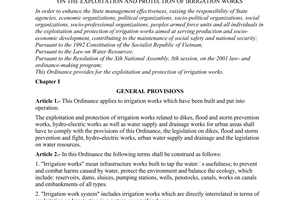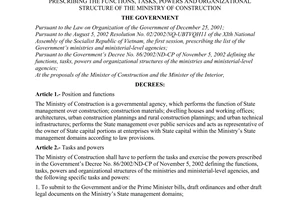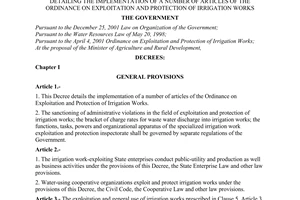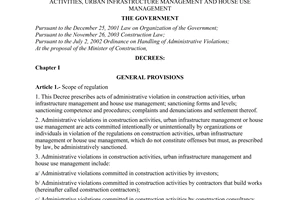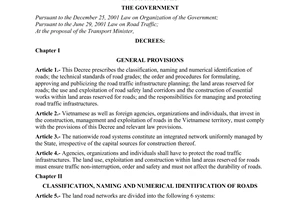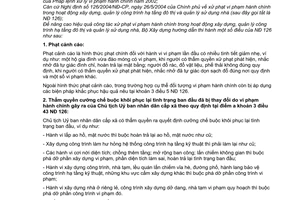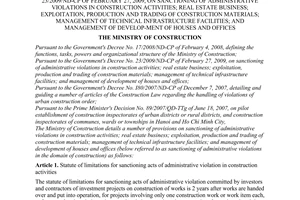Circular No. 01/2005/TT-BXD, promulgated by the Ministry of Construction, guiding in detail the implementation of a number of articles of the Government's Decree No. 126/2004/ND-CP dated May 26, 2004 on the sanctioning of administrative violations in urban infrastructure construction and management and house use management activities. đã được thay thế bởi Circular No. 24/2009/TT-BXD of July 22, 2009, detailing a number of provisions of The Government's Decree No. 23/2009/Nd-Cp of February 27, 2009, on s và được áp dụng kể từ ngày 09/09/2009.
Nội dung toàn văn Circular No. 01/2005/TT-BXD, promulgated by the Ministry of Construction, guiding in detail the implementation of a number of articles of the Government's Decree No. 126/2004/ND-CP dated May 26, 2004 on the sanctioning of administrative violations in urban infrastructure construction and management and house use management activities.
|
THE MINISTRY OF CONSTRUCTION |
SOCIALIST REPUBLIC OF VIET NAM |
|
No. 01/2005/TT-BXD |
Hanoi, January 21, 2005 |
CIRCULAR
GUIDING IN DETAIL THE IMPLEMENTATION OF A NUMBER OF ARTICLES OF THE GOVERNMENT'S DECREE NO. 126/2004/ND-CP DATED MAY 26, 2004 ON THE SANCTIONING OF ADMINISTRATIVE VIOLATIONS IN URBAN INFRASTRUCTURE CONSTRUCTION AND MANAGEMENT AND HOUSE USE MANAGEMENT ACTIVITIES
Pursuant to the Government's
Decree No. 36/2005/ND-CP dated March 4, 2003 defining the functions, tasks,
powers and organizational structure of the Ministry of Construction;
Pursuant to the Government's Decree No. 134/2003/ND-CP dated November 14, 2004
detailing a number of articles of the 2002 Ordinance or Handling of
Administrative Violations;
Pursuant to the Government's Decree No. 126/2004/ND-CP dated May 26, 2004 on
sanctioning of administrative violations in urban infrastructure construction
and management and house use management activities (hereinafter called Decree
No. 126 for short);
In order to raise the effectiveness of the sanctioning of administrative
violations in urban infrastructure construction and management and house use
management activities, the Ministry of Construction hereby guides a number of
Articles of Decree No. 126 as follows:
1. Caution:
Caution is a principal sanctioning form applicable to first-time violations involving many extenuating circumstances, for example: a household which commits a violation in digging ground for house foundation voluntarily stops such violation act and restores the ground after persons with sanctioning competence detect such act and give a warning; or a person who has dumped garbage, materials or discarded materials not at the prescribed place voluntarily cleans up such place, then dumps such things at the prescribed place after persons with sanctioning competence detect such act and give a warning, or some other violations.
Apart from caution, in some specific cases administrative violators may be subject to the application of consequence-addressing measures prescribed in Clause 3, Article 5 of Decree No. 126.
2. Competence of presidents of commune-level People's Committees to force the restoration of the original state already altered due to administrative violations according to the provisions of Point a, Clause 3, Article 43 of Decree No. 126.
Presidents of commune-level People's Committees are competent to issue coercive decisions to force the restoration of the original state, for example:
- For acts of filling ponds, lakes or water surfaces, they shall force the restoration of the original state of such ponds, lakes or water surfaces;
- For acts of building works, which damage the system of technical infrastructures, they shall force violators to repair such infrastructures to the original state;
- For acts of expanding houses in flooring spaces by adding more stories, enlarging balconies, or encroaching upon common aerial spaces without permission, they shall force the dismantlement of violating construction sections, or encroached areas in order to restore the initial state;
- For acts of building make shift works or houses, or erecting tents or stalls which encroach upon pavements, streets, technical infrastructure protection corridors or other areas where construction is prohibited, they shall force the dismantlement of violating work sections.
- For acts of building separate dwelling houses, unfinished construction works or makeshift houses in violation of the construction planning, they shall force the dismantlement of such violating work sections.
3. Conditions on capability of organizations and individuals engaged in construction activities:
The conditions on operation capability of organizations and professional capability of individuals engaged in construction activities are prescribed in the Construction Law and guiding documents.
4. Competence to confiscate material evidences and means used in administrative violations
Persons with sanctioning competence, when applying measures of confiscating material evidences or means in order to prevent violations from further occurring, shall decide on confiscation thereof according to their competence on the basis of preliminary valuation according to market prices. If the preliminary valuation of material evidences and means goes beyond their competence, they shall, within two working days, have to report such to competent persons for decision.
For construction inspection forces, persons competent to temporarily seize material evidences and means defined in the 2002 Ordinance on Handling of Administrative Violations shall be
inspectors, chief inspectors of provincial/municipal Construction Services and the chief inspector of the Ministry of Construction.
5. Temporary seizure of material evidences and means used for committing administrative violations:
When persons with sanctioning competence have grounds to believe that if not being temporarily seized, such material evidences and means may be used for committing further violations or be dispersed, they shall have to issue decisions on temporary seizure thereof, such as trucks carrying bulk materials or discarded materials, generating dusts and making streets dirty; construction equipment, tools, fuels, materials, etc., are used in construction of violating works as well as other violation acts.
6. Deduction of bank accounts:
In cases where administrative violators are imposed with pecuniary fines, have bank accounts but refuse to execute sanctioning decisions, persons competent to sanction administrative violations shall send decisions on forcible execution to banks where such violators open their deposit accounts so that the banks make deductions according to law provisions.
7. Land with use purposes not yet changed as specified at Point b, Clause 1, Article 6 of Decree No. 126:
Land with use purposes not yet changed means land of categories where, according to regulations, the use purpose change must be applied for by investors upon construction of works thereon, as specified in Clause 1, Article 13 of the 2003 Land Law, including:
a) Land under annual crops, including land under rice and pasture land for cattle raising, and land for other annual crops;
b) Land under perennial trees;
c) Land under production forests;
d) Land under protection forests;
e) Land under special-use forests;
f) Land for aquaculture;
g) Land for salt making;
h) Other agricultural land as prescribed by the Government.
8. Areas where construction is prohibited, as defined in Clause 3, Article 6 of Decree No.126:
Building works by investors on areas where construction is prohibited is an act of constructing works in encroachment upon protection zones prescribed by law, including:
a) Dike protection corridors, which are prescribed in:
- Clause 1, Article 18 of the 2000 Ordinance on Dikes;
- Article 7 of the Government's Decree No. 171/2003/ND-CP dated December 26, 2003;
b) Irrigation work protection corridors, which are prescribed in:
- Article 25 of the 2001 Ordinance on Exploitation and Protection of Irrigation Works;
- Article 23 of the Government's Decree No. 143/2003/ND-CP dated November 28, 2003 on exploitation and protection of irrigation works;
c) Traffic work protection corridors:
- For road traffic works: such corridors are defined in Clause 2, Article 42 of the Government's Decree No. 91/CP dated August 17, 1994; Articles 13, 14, 15, 16, 17 and 18 of the Government's Decree No. 186/2004/ND-CP dated November 5, 2004.
- For inland waterway navigation works: such corridors are defined in Articles 5, 6, 8 and 9 of the Government's Decree No. 171/1999/ND-CP dated July 12, 1999.
d) Oil and gas work protection corridors, defined in Clauses 1 and 2, Article 3; Article 4; Points e, f, g and i, Clause 1, Article 5 of the Government's Decree No. 10-CP dated February 17, 1993 and Points a and b, Clause l, Article 5 of Decree No. 47/1999/ND-CP dated July 5, 1999;
e) Electric power work protection corridors defined in Articles 6, 8, 12 and 14 of the Government's Decree No. 54/1999/ND-CP dated July 8, 1999;
f) Protection zones of historical relics, defined in Article 32 of the 2001 Cultural Heritage Law;
g) Protection corridors of security and defense works and other areas prescribed by law.
9. Safety zones of underground water wells, specified in Clause 1, Article 25 of Decree No. 126:
Violations of regulations in Construction Standard TCXD 33.1985 (11 .21), including:
a) Zone I - For water-holding layers which are well protected, the safety zone must not be narrower than 30 meters. Any livestock stables and ranches must be built 100 meters away from the zone boundaries.
b) Zone II - For water-holding layers not protected or not well protected, the safety zone must not be narrower than 50 meters. Any livestock stables and ranches must be built 300 meters away from the zone boundaries.
10. Safety protection zones of surface water sources, defined at Point b, Clause 2, Article 26 of Decree No. 126:
The scope of safety protection zones of surface water sources is prescribed in Section 11 of Construction Standard TCXD 33.1985.
11. Scope of safety protection corridors of crude water mains and clean water pipelines defined in Article 27 of Decree No. 126:
Violations of regulations at Point 8.31, Section 8 of Construction Standard TCXD 33.1985 ''Regulations on pipelines, pipeline networks and works on networks.''
12. Use of condominiums in contravention of regulations on condominium use purposes, thus causing order disturbance and insecurity, defined in Clause 1, Article 38 of Decree No. 126:
This means act committed by condominium apartment owners using or letting other persons to use their condominium apartments for purposes in contravention of current regulations on management of use of condominiums, for example:
a) Using condominiums as production or business establishments, working offices or other purposes than dwelling purpose;
b) Using condominium apartments for conducting business lines or trades involving or trading in fire- and/or explosion-prone commodities (welding, gas, explosive materials and other dangerous business lines or trades); providing services which cause noises in excess of the prescribed level (Karaoke bars, dancing halls, motorbike and automobile garages and other service activities causing noises in excess of the permitted level); disturbing the public order (not in the domain of construction order management); talking or using equipment causing noises which may affect the daily life of households living in condominiums and other acts affecting order and security of condominiums;
13. Causing pollution of condominiums, defined in Clause 1, Article 38 of Decree No. 126:
This means act of discharging excrement, garbage, wastewater or hazardous matters; causing water penetration and leakage; keeping
cattle or poultry within areas under common ownership; keeping cattle or poultry in areas under private ownership thus affecting living environment of other households and public places; providing services which cause environmental pollution (cattle slaughterhouses, car washing and other polluting services).
14. Condominium sections under joint ownership defined at Point a, Clause 2, Article 38 of Decree No. 126:
These mean areas of condominiums, including:
a) Spaces and force-bearing structures, technical facilities and equipment for common use in condominiums (pillar frames, walls, floors, roofs, terraces, corridors, stairways, elevators, emergency exits, garbage discharge enclosures, technical boxes, car parks; electricity, water and gas supply, information, communications, radio and television, water drains, septic tanks, lightning rods, fire-
fighting devices, etc.);
b) External technical infrastructure systems attached to such condominiums.
c) Other areas not under private ownerships according to provisions of law.
15. Administrative violation-sanctioning order applicable to violating construction works:
a) Parts of violating construction works must be promptly detected;
b) To make written records of administrative violations, ordering the stoppage of construction violation acts;
c) To issue sanctioning decisions immediately. Such sanctioning decisions must clearly state measures to force violating organizations or individuals to restore the original state, for example: dismantlement of illegally expanded sections, construction work items, expanded or encroached areas, and concurrently set time limits for addressing the consequences.
d) Past the time limits inscribed in sanctioning decisions, if violating organizations or individuals still fail to execute such decisions, to coerce them to do so. All expenses for coercion must be borne by violating organizations or individuals.
16. Enclosed forms:
Promulgated together with this Circular are 8 set forms of written records of administrative violations, sanctioning decisions and (enclosed) reports.
17. Handling of administrative violations in transitional period:
a) Regarding cases for which sanctioning decisions or work dismantlement decisions have already been issued under the Government's Decree No. 48/CP dated May 5, 1997 and are still valid, but violators fail to execute them, the violators shall still have to abide by such decisions;
b) Acts of administrative violation in urban infrastructure construction and management and house use management activities, committed before the effective date of Decree No. 126/2004/ND-CP which have not yet been detected and sanctioned, shall, after being detected, be sanctioned according to the provisions of Decree No. 126/2004/ND-CP.
18. Implementation provisions:
a) This Circular takes effect 15 days after its publication in the Official Gazette.
b) Regarding the sanctioning competence of construction specialized inspectorate of Hanoi city.
Such competence shall comply with the Prime Minister's Decision No. 100/2002/QD-TTg dated July 24, 2002 permitting the experimental setting up of construction specialized inspectorate in Hanoi and with current legal documents.
c) The ministers, the heads of the ministerial-level agencies, the heads of the Government-attached agencies and the presidents of the People's Committees of the provinces and centrally-run cities shall have to implement this Circular.
d) Any problems arising in the course of implementation should be reported by the provincial/municipal People's Committees and Construction Services to the Ministry of Construction.
|
|
FOR THE MINISTER OF CONSTRUCTION |



